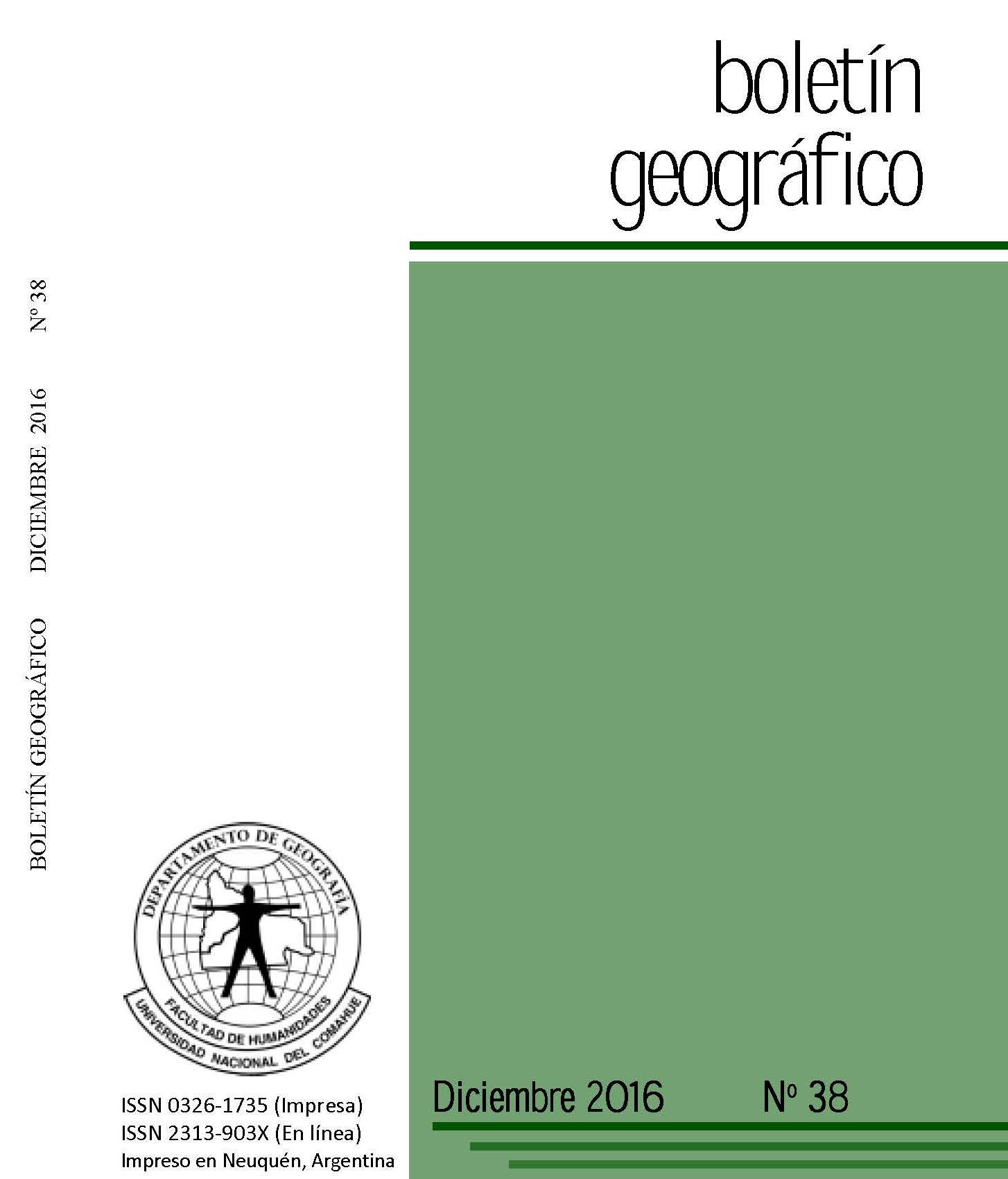Morphological typification ofel negro stream in its lower basin. Ventania system, argentina
Keywords:
Fluvial morphology, Ventania System, watercourses typification, basinsAbstract
Rivers are natural, dynamic and complex systems. Its main function is the transportation of water, sediments and nutrients, conforming areas of great ecological and territorial value. Morphology varies according to the structure and the drainage network. Fluvial systems typification classifies and characterize rivers in order to provide substantial information about every section. Although there are
several classifications and characterizations, Rosgen’s combines hydrological, geomorphological and ecological aspects that serves as important indicators towards this study. River classifications are relevant to understanding natural systems and their function, being an instrument of major importance in territorial planning, which
provides a significant benefit to environment and society. The area encloses the lower basin of El Negro stream in Sierra de la Ventana, Argentina. Thehomonym village occupies part of the floodplain of the main channel. In recent years, the real estate pressure in these areas led to the opening of new subdivisions for the construction of resorts, changing the stream morphology. The aim of this work is to
morphologically characterize and typify a section located in the lower basin of El Negro stream to generate a methodology applicable to other courses in the sector. Before typification, sectioning was implemented following criteria by Ollero Ojeda y otros (2003) and utilizing aerial photographs. The corresponding portion of the
lower basin was selected for morphological characterization as the one showing major changes due to being in the urbanized area. The investigation was done based on Thorne’s methodology (1998), and afterwards typified following Rosgen’s criteria (1994). The typification resulted in a A3 stream category based on its morphological characteristics. The methodology allows to comprehend fluvial dynamics and gather data from a sector where scarces or nonexists, in order to generate representative information about hydrogeomorphological conditions that may be taken into account by authorities.
Downloads
References
ANDREIS, R.; IÑIGUEZ, A.; LLUC, J. y RODRÍGUEZ, S. (1989). Cuenca paleozoica de Ventania, Sierras Australes, provincia de Buenos Aires En: G. Chebli & Spalletti (Eds.) (pp. 265-298). Cuencas Sedimentarias Argentinas. Instituto Superior de Correlación Geológica, Universidad Nacional de Tucumán, San Miguel de Tucumán.
ANDREIS, R. y JAPAS, M. (1996). Cuencas Sauce Grande y Colorado. En: Archangesiky (ed.) El Sistema Pérmico de la República Argentina y en la República Oriental del Uruguay. Academia Nacional de Ciencias, Córdoba.45-64.
BUFFINGTON, J. M. y MONTGOMERY, D. R. (2013). Geomorphic classification of rivers. In: Shroder, J.; Wohl. (Eds). Treatise on Geomorphology; Fluvial Geomorphology, Vol. 9. 730-767.
CASTILLO SÁNCHEZ, V. y GONZÁLEZ ALONSO, S. (1986). Características morfológicas de los paisajes fluviales madrileños. Papeles de Geografía, n°11. 53-62.
ESCORZA, C. (2011). Algunos rasgos de los meandros del río Ebro en su curso próximo a Calahorra. Revista Kalakorikos 16. 307-317.
GIL, V. (2010). Hidrogeomorfología de la cuenca alta del río Sauce Grande aplicada al peligro de crecidas. Tesis doctoral en Geografía. Universidad Nacional del Sur, Bahía Blanca.
GIL, V. (2011). Geomorfología fluvial en el arroyo El Negro, Buenos Aires, Argentina. DALLAL, G.E. (1986). An analytic approximation to the distribution of Lilliefors's test statistic for normality. The American Statistician,40:294-296.
DRAPER, N. R. y SMITH, H. (1998). Applied Regression Analysis, 3rd Edition. Ed. Wiley. New York. 736 pp.
LONGLEY, R. W. (1973). Tratado Ilustrado de Meteorología. Editorial Bell. Buenos Aires. 345 pp.
MINETTI, J. L. y VARGAS W. M. (1990). Comportamiento del borde anticiclónico subtropical en Sudamérica-II Parte. Rev. Geofísica Nº 33, 179-190.
MONTGOMERY, D.;JENNINGS, L., KULAHCI, M. (2008). Introduction to Time Series Analysis and Forecasting. Ed. Wiley. New York. 472 pp.
POBLETE, A. G. y IRANZO, D. A. (2012). Análisis de los factores de circulación atmosférica regional y cupla océano-atmósfera que generaron el período nival mas seco del siglo XX en los andes centrales de Argentina y Chile. IX Jornadas Nacionales de Geografía Física. Bahía Blanca, 19 al 21 de abril de 2012.
POBLETE, A. G. y ESCUDERO, S. (2013). La sequía en los Andes Centrales y su repercusión en los ríos San Juan y Mendoza. IV Congreso Nacional de Geografía de Universidades Públicas y XI Jornadas Cuyanas de Geografía. Mendoza. 23, 24 y 25 de Octubre de 2013.
POBLETE, A. G. y HRYCIW, M. C. (2015). Validación Índice PSGO. Revista Cuadernos de Geografía. Colombia. En prensa.
QUINTANA, J. M. y ACEITUNO, P. (2012). Changes in the rainfall regime along the extratropical west coast of South América (Chile): 30-43º S. Atmósfera 25(1), 1-22.
VIALE, M. (2010). Características de las Precipitaciones Orográficas de invierno sobre los Andes Subtropicales Centrales. UBA. FCEyN. Tesis Doctoral. http://digital.bl.fcen.uba.ar/gsdl-282/cgi-in/library.cgi a=d&c=tesis&d=Tesis_4707_Viale
ZWACK, P. y OKOSSI, B. (1986). A new method for solving the quasi-geostrophic omega equation by incorporating surface pressure tendency data. Monthly Weathe Review 114(4), pp. 655-666.evista Universitaria de Geografía, V. 20, n°1, 1-12.
GUTIÉRREZ ELORZA, M. (2008). Geomorfología. Prentice Hall.
HARRINGTON, H. (1947). Explicación de las hojas geológicas 33m y 34m Sierra de Curamalal y de la Ventana. Provincia de Buenos Aires. Ministerio de Industria y Minería. Buenos Aires, Argentina. 43 pp.
HORACIO, J. y OLLERO, A. (2011). Clasificación geomorfológica de cursos fluviales a partir de Sistemas de Información Geográfica (SIG). Boletín de la Asociación de Geógrafos Españoles Nº 56. 373-396.
IBISATE, A., OLLERO, A. y DÍAZ, E. (2011). Influence of catchment processes on fluvial morphology and river habitats. Revista Limnetica. Vol.3 0. 169-182.España: Asociación Ibérica de Limnología.
JIMÉNEZ SÁNCHEZ, M. (1999). Geomorfología fluvial en la cabecera del rio Nalón (Cordillera Cantábrica, Noroeste de España), Trabajos de Geología, n°21. 189- 200.
MORISAWA, M.E. (1985). Rivers, form and processes. Longman, London. 222 pp.
NASCENTES COELHO, A.L. (2008). Geomorfología Fluvial de ríos impactados por Barragens. Caminhos de Geografía, Vol.9, n°26. 16-32.
OLLERO OJEDA, A.; ECHEVERRÍA ARNEDO, T.; SÁNCHEZ FABRE, M.; AURÍA IZQUIERDO, V.; BALLARÍN FERRER, D. y MORA MUR, D. (2003). Metodología para la tipificación hidromorfológica de los cursos fluviales de Aragón en aplicación de la directiva Marco de Aguas (2000/60/CE). Geographicalia44, 7-25.
PEDRAZA GILSANZ, J. (1996). Geomorfología. Principios, métodos y aplicaciones. Editorial Rueda. Madrid.España. 414 pp.
PEDRAZA GILSANZ, J. (2001). Geomorfología e hidrología fluvial del río Alberche. Modelos y SIG para la gestión de riberas. Tesis doctoral, Universidad Complutense de Madrid, Madrid. 610 pp.
PETTS, G.E. y FOSTER, I. (1985). Rivers and landscape. London, Edward Arnold Ltd. 274.
PETTS, G.E. y AMOROS, C. (1996). Fluvial hydrosystems. London, Chapman y Hall Ltd. 322 pp.
ROSGEN, D. L.A. (1994) Classification of natural rivers. Wildland Hydrology, I Steven’s Lake Road, Pagosa Springs, CO 81147, USA.
RUST, B.R. (1978). A classification of alluvial channel systems. In: A.D. Miall (Editor), Fluvial Sedimentology. Can. Soc. Petrol. Geol., Calgary, Mem., 5: 187-198.
SCHUMM, S.A. (1963). A Tentative Classification of Alluvial River Channels. An examination of similarities and differences among some Great Plains rivers. Geological Survey 477, Washington, USA.
SOBRERO, F.; RAMONELL, C.; PEREIRA, M.S. (2014). Cambios morfológicos del cauce principal del río Paraná en Argentina, Siglo XIX a la actualidad, Rev. Aqua-Lac, Vol.6, n°1. 50-62.
THORNE, C.R. (1998). Stream Reconnaissance Handbook. John Wiley y Sons Ltd. 133 pp.
ZABALA, C. y QUATTROCCHIO, M. (2001). Estratigrafía y evolución geológica del río Sauce Grande Cuaternario), provincia de Buenos Aires, Argentina. Revista de la Asociación Geológica Argentina, 56 (1). 25-37.
Downloads
Published
How to Cite
Issue
Section
License
Copyright (c) 2016 Boletin GeográficoTransfer of rights and data processing
The acceptance of an article for publication in the Journal Geographic Bulletin implies the cession of the rights of printing and reproduction, by any means and means, of the author in favor of the Department of Geography of the National University of Comahue, which will not reject any request reasonable for the authors to obtain permission to reproduce their contributions. The total or partial reproduction of the works published in the Geographic Bulletin must be done citing the origin, otherwise, the copyright is violated.
Likewise, it is understood that the concepts and opinions expressed in each work are the sole responsibility of the author, without being responsible or in solidarity, necessarily, neither the editorial staff nor the editorial staff.
It is the responsibility of the authors to be able to provide interested readers with copies of the raw data, procedure manuals, scores and, in general, relevant experimental material.
Likewise, the Management of the journal guarantees the appropriate treatment of personal data
COPYRIGHT TRANSFER FORM


















 Journal of the
Journal of the 